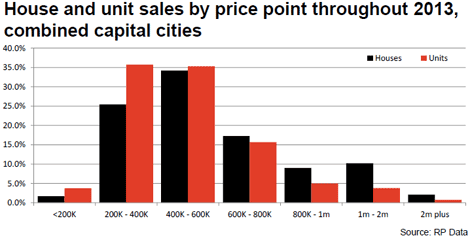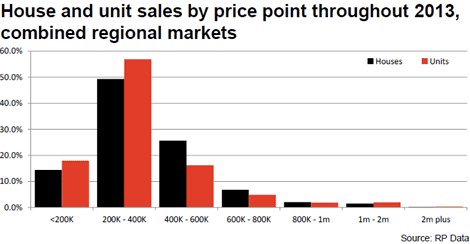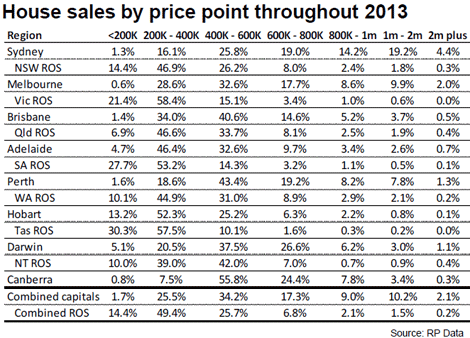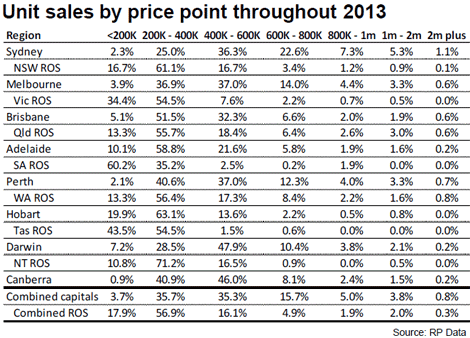Fewer homes selling across affordable price points and disparity will only grow
Almost two years has passed since the property market kicked in again and commenced another cycle of growth. Looking back at how the market performed over this period, a larger proportion of home sales crept into the higher price brackets.
2013 ended as a strong year for the property market where a healthy increase in house and unit sales coupled with a rise in home values of 9.8% across the combined capital cities was recorded. We saw median selling prices of capital city homes increased by a greater 10.2% over the year, indicating a shift to more expensive properties transacting throughout the year.

An analysis of Australia’s combined capital cities revealed that there is quite a difference in pricing between houses and units where only 27.1% of capital city houses sold for less than $400,000 in 2013 compared to 39.4% of all units.

For the same period, unit sales between $200,000 and $400,000 accounted for the greatest proportion of sales in 2013 at 35.7% while sales ranging from $400,000 to $600,000 accounted for the greatest proportion of house sales at 34.2%. Across the combined capital cities, 12.4% of house sales and 4.6% of unit sales were at or above $1 million.
At a combined capital city level, 27.1% of house sales were at prices below $400,000 compared to 63.8% across the regional markets. Similarly, 74.8% of all regional unit sales were below $400,000 in 2013 compared to 39.4%.
The proportion of home sales with a million dollar price tag or higher was lower in regional markets with just 1.7% of all regional house sales and 2.3% of regional unit sales at a price in excess of $1 million.

For state-based house sales, the proportion of homes sold below $200,000 and between $200,000 and $400,000 is greater in regions outside of the capital cities or ‘rest of state’ as it is often referred to. This highlights the fact that home prices are typically lower in regional markets than those in capital city areas.

The results for regional unit markets are similar to those for regional houses. The proportion of unit sales below $200,000 in regional areas is much greater than the proportion within the corresponding capital city.
Interestingly, in Australia’s two most affordable capital cities, Adelaide and Hobart, the proportion of unit sales between $200,000 and $400,000 is greater within the capital cities than within the regional market which is likely due to the fact that unit markets outside of these capitals have little depth of stock.
Relative to rest of state markets, the data highlights that the selling prices of homes in capital cities is significantly higher. With around 66% of Australian’s living within a capital city it is clear that competition for housing, particularly well located housing, is driving up selling prices - the current low mortgage rates are only intensifying this competition.
Across each city there are still homes selling at prices below $400,000 however, these homes are becoming rare and are usually located on the outskirts of the city in areas that are poorly supported by essential infrastructure.
Perhaps businesses and governments should be looking at ways to create jobs in regional markets as a way of making housing more affordable. At the moment, there seems to be lack of enthusiasm at all levels of government to provide a sustainable fix to housing affordability in our capital cities. As a result we would expect that the proportion of homes selling below $400,000 will continue to decline over the coming years.
Cameron Kusher is senior research analyst at RP Data.